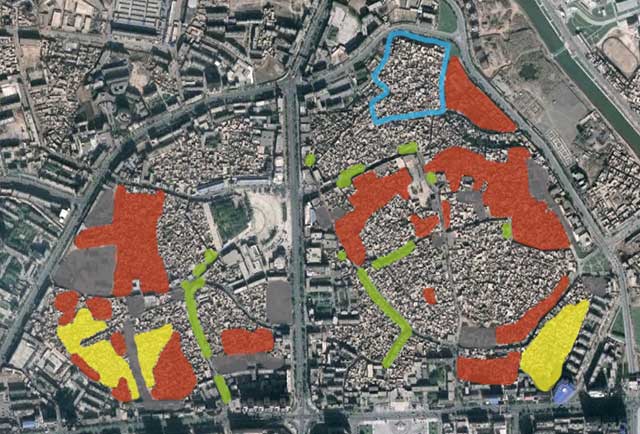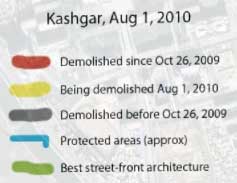Progress of Demolition of Kashgar

Google Earth mapping of demolition of Kashgar by Stefan Geens (ogleearth.com), click for larger version

Last year warnings were raised around the world about the impending demolition of most of the ancient old quarter of Kashgar, a key city along the fabled Silk Road caravan route between west and east, located in China’s Xinjiang province (aka Uyghur Autonomous Region) near the westernmost border of China. Before demolition started, the city was considered “the best-preserved example of a traditional Islamic city to be found anywhere in central Asia.” The government plans to demolish 85% of the old town, replacing the old buildings and fabric with modern housing and development “in local style”, ostensibly to improve the local economy and living standards of residents, and ensuring housing can withstand an earthquake, though whether those are just convenient excuses is subject to a lot of discussion that I’d rather not get into. Stefan Geen (of “neogeo” website ogleearth.com) made a trip to Kashgar in late July 2010 and thoroughly documented the extent of demolition as of August 1, 2010 in Google Earth and on his website, and extensively photographed what remains and the people he met there, all mapped and located in his KMZ file for Google Earth (which you should check out for full interactivity). Above is his map of what has been demolished, and what was in the process of being demolished while he was there, as well as showing the small area that will be preserved for your typical Chinese tourist trap.
While the overall effect so far from the air perhaps doesn’t seem as shocking as the demolition of Tianjin’s old town I wrote about earlier (without more uptodate airphotos, the destruction is not yet obvious, the base is the latest Google Earth has, from October 26, 2009), the damage to the cultural heritage and tourism prospects of Kashgar will certainly be far, far worse once demolition is completed. It is frankly shocking that Kashgar was not made a UNESCO World Heritage Site, something that would have certainly at least preserved the physical character of the old town, and is an incredibly popular route for Chinese heritage tourism spots these days (China has the 3rd highest number of World Heritage Sites in the world, and growing). Of course, the country itself has to nominate the place to become designated a World Heritage Site, which likely explains why Kashgar has never been designated. While being designated is not some kind of magical panacea of preservation (leading as it almost inevitably does to massive tourism and the changes of ownership, character and development that brings with it), the degree of preservation that does occur, whether through international or financial pressures from UNESCO, can be gauged by the fact that only 2 World Heritage sites have ever been delisted for destroying the character that led to designation.
In any case, I was hoping to make it to Kashgar to experience its unique ancient character before demolition, but not sure I’ll make it now (the disturbances in Xinjiang last year didn’t help). Actually, I just came back from Shangri-La (or at least, the self-named Shangri-La which is not the same thing at all, with a stop in Lijiang, another World Heritage Site), which ironically, despite the name, is a far cry from the unique, isolated kind of place that I imagine Kashgar is (or is that was?).

2 Comments so far
Leave a comment
[…] only found out about Bricoleurbanism because its (anonymous) author wrote up my earlier post about Kashgar. I’m glad to see somebody else is keeping tabs on the […]
By Open Mobile Map » Check out Bricoleurbanism on 03.17.11 6:16 am
Check photos and info:
http://www.celestinoarce.com/reportaje/kashgar/
By hal on 05.22.12 6:02 pm
Leave a comment
Line and paragraph breaks automatic, e-mail address never displayed, HTML allowed:
<a href="" title=""> <abbr title=""> <acronym title=""> <b> <blockquote cite=""> <cite> <code> <del datetime=""> <em> <i> <q cite=""> <s> <strike> <strong>